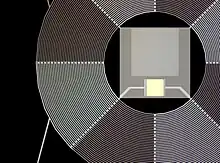Netherlands Institute for Space Research
SRON Netherlands Institute for Space Research (SRON) is the Dutch expertise institute for space research. The institute develops and uses innovative technology for analysis in space, focusing on astrophysical research, earth observation, and exoplanetary research. SRON conducts research into new and more sensitive sensors for X-rays, infrared radiation, and visible light.
| Ruimteonderzoeksinstituut SRON | |
 SRON, Leiden; 2021 | |
| Agency overview | |
|---|---|
| Abbreviation | SRON |
| Formed | 1983 |
| Type | Space agency |
| Headquarters | Leiden |
| Administrator | Michael Wise (Scientific Director) |
| Employees | 250 |
| Website | www |
SRON was founded in 1983 under the name Stichting Ruimteonderzoek Nederland (SRON; lit. transl. Foundation Space-research Netherlands) as part of the Dutch Research Council (NWO), consisting of space labs in Leiden, Utrecht and Groningen. Later, the Leiden lab merged with the Utrecht location. As of 2005, this institute is called SRON Netherlands Institute for Space Research. In 2021 the Utrecht lab moved back to Leiden. Since then, SRON has been headquartered in Leiden with additional facilities in the city of Groningen.
Science and technology
The institute has over 250 staff members who are employed in four programme lines—Astrophysics, Earth observation, Exoplanets, Technology––and two expertise groups––Engineering and Instrument science.
Technology
SRON's ambition is to act as a leading institute in developing state-of-the-art satellite instruments for space research missions of ESA, NASA , and other agencies. Through the years, SRON technology has contributed to many ground-breaking space missions, mainly dedicated to mapping the infrared sky (e.g., IRAS, ISO, HIFI/Herschel), analyzing X-ray and gamma-ray sources (e.g., CGRO/COMPTEL, Beppo-SAX, Chandra, XMM-Newton), and studying the Earth atmosphere (SCIAMACHY/ENVISAT and TROPOMI). The institute is also working on missions that will study other planets beyond the Solar System. Examples of future missions to which SRON will contribute to are Athena (X-ray), LISA (gravitational waves), PLATO (exoplanets), GUSTO (infrared) and PACE (Earth observation).
Missions and projects
Current missions or projects with SRON contribution
SRON instruments are named in parentheses.
- Athena (X-IFU)
- Chandra (Low Energy Transmission Grating Spectrometer (LETG))
- XMM-Newton (Reflection Grating Spectrometers (RGS))
- INTEGRAL
- CO2M
- HUBS
- POEMM
- XRISM (Resolve Soft X-Ray Spectrometer)
- LOFT
- ALMA (2 band receivers)
- Sentinel-5p (TROPOMI)
- Sentinel 5 (Immersed gratings)
- MetOp (GOME-2)
- GUSTO (8-pixel camera)
- ARIEL
- PLATO
- PACE (SPEXone)
- LISA (Quadrant Photo Receivers; Mechanism Control Unit)
Technology development

In various wavelength areas, SRON's sensors are already some of the most sensitive in the world. However, SRON is continuously looking for new ways to deploy even more sensitive sensors for the improved detection of cosmic radiation or measurements of the atmosphere of Earth and other planets. This requires long-term investments in the development of new sensors, electronics and specialist techniques. In the near future, detectors shall increasingly take the shape of large chips with many megapixels and a unique combination of two-dimensional pictures and spectroscopy color resolving power.
These detectors require the development of new advanced electronics, smart control software, extreme cooling techniques, and novel materials. SRON develops a new generation of detectors and the necessary read-out and control electronics for international missions in the sub-millimeter and far-infrared areas. For example, SRON is developing Kinetic Inductance Detectors (KID) for research in visible light (exoplanets) and far-infrared (star-forming clouds). For the Athena mission, SRON is currently working on Transition Edge Sensors (TES).
National and international partners
SRON collaborates with scientists and international organizations in bilateral, European, and global projects. Within the Netherlands, these include universities in Utrecht, Groningen and Leiden. Outside the Netherlands, an example is the German Aerospace Center (DLR).[1] Through these consortia, SRON is a partner with NASA, ESA and JAXA.
Directors
See also
References
- Hoogeveen, R. W. M.; Yagoubov, P. A.; de Lange, A.; Selig, A. M.; Koshelets, V. P.; Ellison, B. N.; Birk, M. (October 2005). "Superconducting integrated receiver development for TELIS". Sensors, Systems, and Next-Generation Satellites IX. Proceedings of the SPIE. 5978: 440–450.
TELIS (TErahertz and submm LImb Sounder) is a cooperation between European institutes, DLR, RAL, and SRON, to build a three-channel balloon-borne heterodyne spectrometer for atmospheric research.
- "Prof.dr.ir. JAM Bleeker" (in Dutch). Netherlands Institute for Space Research. Retrieved 13 May 2023.
- "Algemeen directeur Karel Wakker verlaat SRON" (in Dutch). Netherlands Institute for Space Research. 30 January 2009. Retrieved 26 June 2016.
- "New directorate at space research institute SRON". Netherlands Institute for Space Research. 21 June 2010. Retrieved 26 June 2016.
- "Michael Wise new Director General at SRON Netherlands Institute for Space Research". Dutch Research Council (NWO). 20 November 2018. Retrieved 17 January 2023.